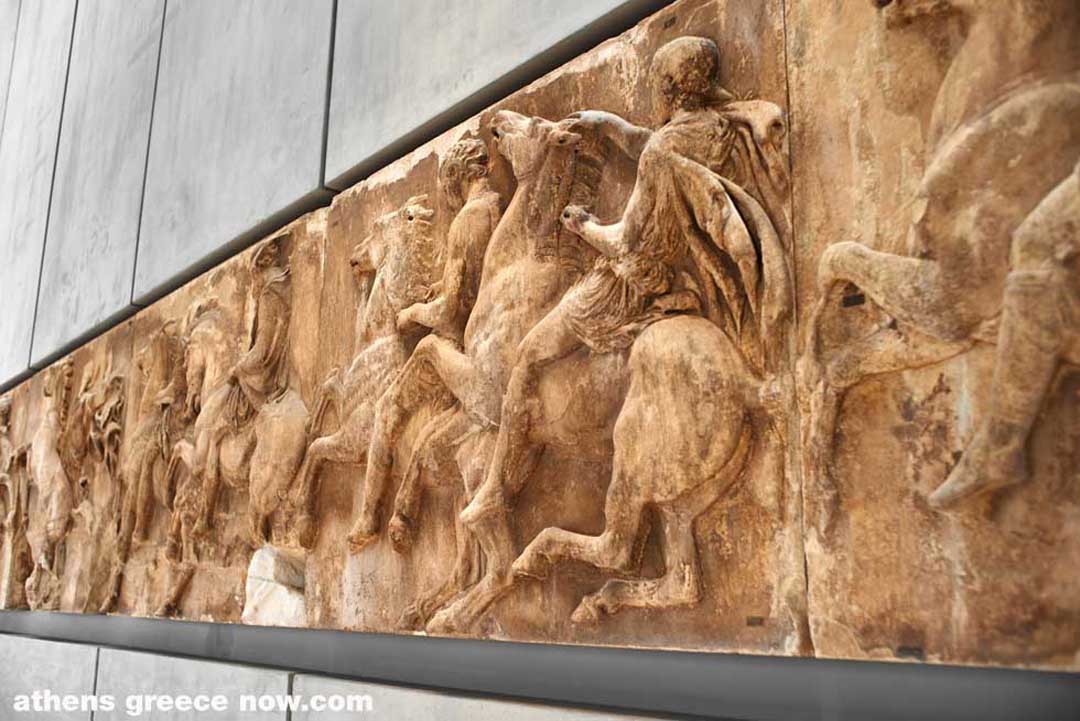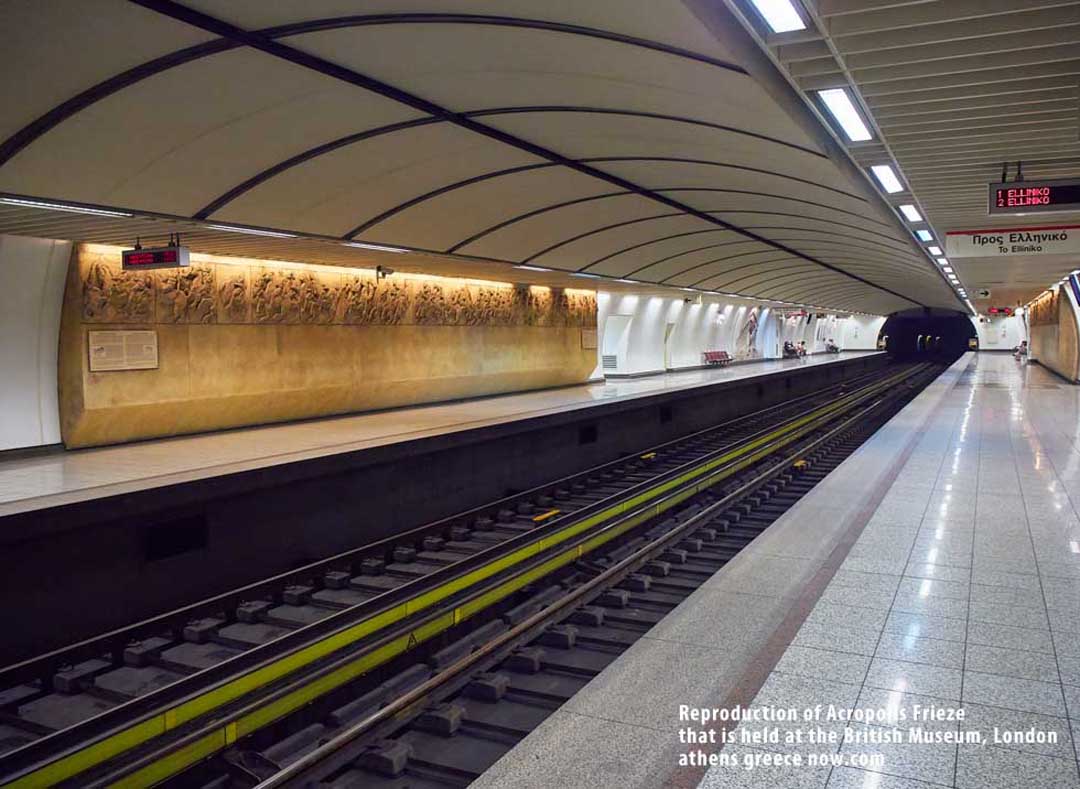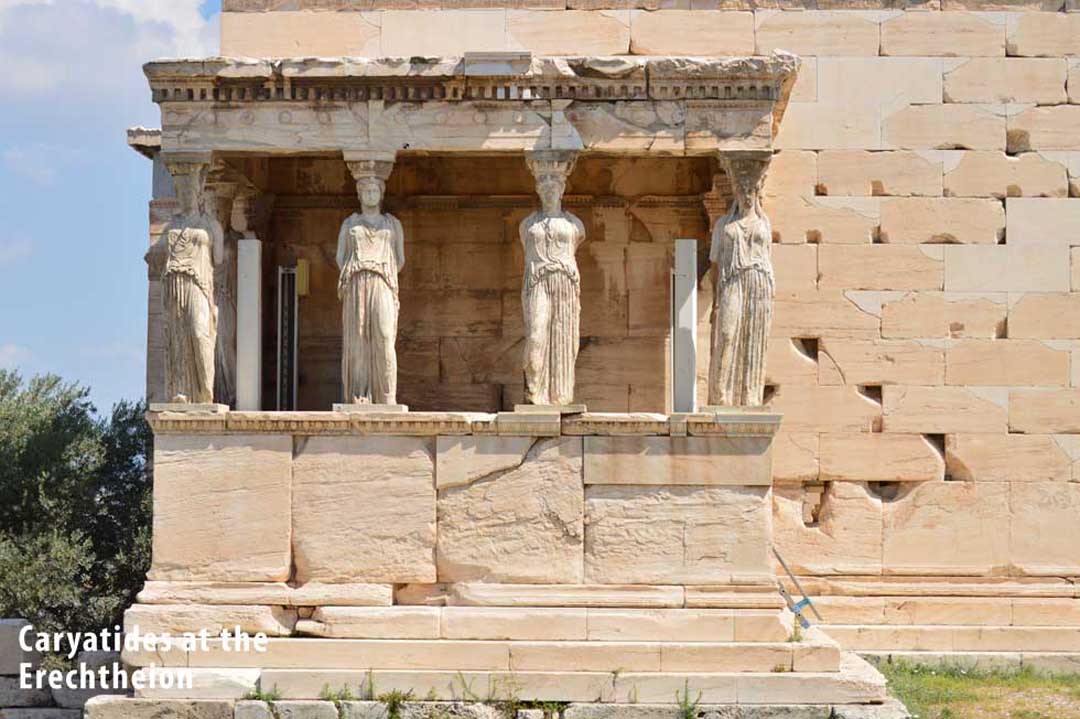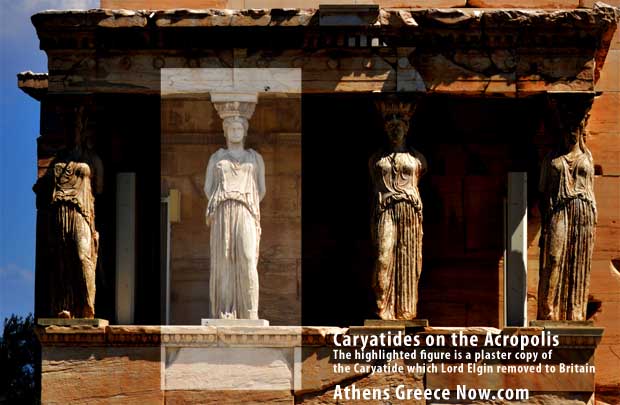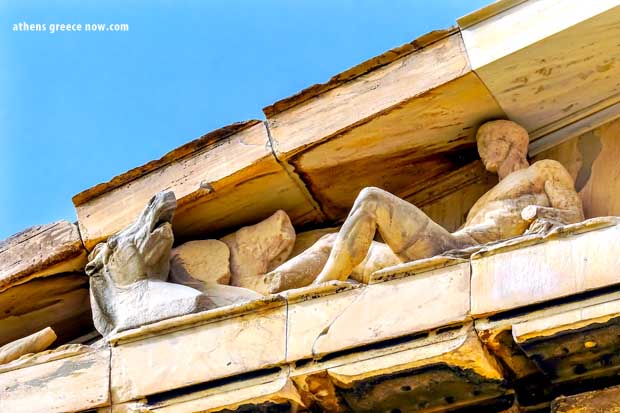The Parthenon Marbles
Last Update: July 14, 2025
aka "Elgin Marbles"
The controversial Parthenon Marbles are a large selection of antiquities taken by Lord Thomas Bruce, the Seventh Earl of Elgin, from Greece and shipped to Britain between 1801 and 1812. The pieces were sold by him to the British Museum in London in 1816.
The Removal of pieces of the Parthenon from Greece
Ownership Arguments about the Parthenon Marbles
ADVERTISEMENT
Guide Book for the Peloponnese: with Athens, Delphi and Kythira – Paperback – Amazon – Bradt Travel Guides, 288 Pages, November 18, 2025
Removal of pieces of the Parthenon: The 'Elgin Marbles'
Tourists and archaeologists have removed pieces from the Acropolis over the centuries. Tourists, in particular, often carried off small marble splinters and pebbles scattered across the Acropolis mount (an act that is now illegal). In earlier times, French and British antiquarians, collectors, and art dealers—both legitimate and illicit—competed aggressively to extract artifacts from Greece and transport them to museums or private collections in their respective countries. These efforts were often driven by a desire to make their national capitals the "center of the art world," which meant acquiring as much original Greek art as possible (as opposed to Roman copies). Ancient Greek artists have long been praised as the most skilled and innovative of the classical world, further fueling this cultural rivalry.
What began as limited removal during the 1700s and 1800s, as Greece became accessible to European visitors, gradually intensified and evolved into a more heated contest, driven in part by the growing financial and cultural value of antiquities. The most famous example is the removal of the Parthenon sculptures from the Acropolis — a group of works often referred to as the "Elgin Marbles." These sections of the Parthenon were shipped to England between 1801 and 1812 by Thomas Bruce, the 7th Earl of Elgin. In the 21st century, the Greek government has promoted the use of the term "Parthenon Marbles" instead, and this label has increasingly been adopted in Western news reporting on the issue.
Elgin claimed approximately half of the surviving statuary at the Acropolis through an arrangement with the Ottoman authorities. At the time, he was 32 years old and serving as the British ambassador to Constantinople, positioned at a favorable moment in history: the Sultan had recently regained substantial Ottoman territory and influence following the British defeat of Napoleon’s forces in Egypt. When Elgin requested an Ottoman firman (a royal permit) to investigate the Acropolis, it was granted. Initially, he had only hired a team of artists and architects to record the site through drawings and measurements, as he had been prohibited from even ascending the Acropolis mount.
Elgin later claimed that his decision to remove sculptures was motivated by concern for their preservation. He observed ongoing damage to the site: poorly paid Ottoman soldiers were reportedly burning marble pieces to make lime; statuary fragments were being used to build fortification walls; and structural elements were dismantled to extract interior lead clamps, which were then melted down for bullets. Elgin also noted that European tourists were increasingly chipping off parts (particularly noses) from statues as souvenirs. As the number of visitors grew, so did the scale of vandalism.
Transporting the crated sculptures to Britain presented numerous challenges. In addition to navigating opposition from the local Ottoman official (the Dizdar) and the occasional angry protests of Athenians who had little power to stop what was happening, Elgin faced logistical difficulties. One ship carrying the crates sank, though the cargo was eventually recovered and transferred to another vessel.* During this period, Elgin had to contrive favors from British military ships to carry the sculptures, a complicated task amid ongoing conflict between Britain and France in the Mediterranean. Some crates ended up stranded in Malta for years, while others that reached Britain were stored in various locations, including the homes of Elgin’s friends.
There are accounts of contemporary opposition to what Elgin was doing. When his men removed a Caryatid from the porch of the Erechtheion, Greeks in Athens rioted, and this may be why the other five figures were not also likewise taken (the one that was taken is at the British Museum, page and image here). Even men working for Elgin had second-thoughts about what they were doing, and in particular the Italian painter Giovanni Battista Lusieri (page at Scotland National Galleries), who was employed as a supervisor by Elgin, characterized it as a "barbarism." Lusieri later lived in Athens, near the Acropolis, until his death in 1821.
Lord Byron, the famous British poet who was particularly interested in Greece (and died in Missolonghi in 1824, having come to join the Greeks in the revolution against the Turks), mocked Elgin's efforts in his poem Childe Harold's Pilgrimage, published in four sections between 1812 - 1818. In the poem, Elgin is characterized as a plunderer upon Hellas, that he is the "...last, the worst..."
Elgin had been driven nearly to bankruptcy by his project of removing the marbles to England, spending nearly £60,000 in the process. He also suffered public humiliation through a divorce from his wife and was captured and imprisoned by Napoleon with circumstances surrounding his later parole ultimately forced him to resign from the House of Lords. During his long tour abroad, he also experienced facial disfigurement, with his nose in particular deteriorating. Some attributed this to syphilis, though another plausible explanation is severe rosacea exacerbated by prolonged exposure to the strong Mediterranean sun.
In 1806, Elgin finally returned to England and gathered the boxed pieces (numbering around 200 crates shipped out of Greece) from friends and various storage locations. In 1807, he began exhibiting them at Gloucester House, located at the corner of Park Lane and Piccadilly.
Ten years later, Elgin sold his collection to the British government. Some sources say he initially sought £70,000, others cite £50,000, but in 1807 the British government offered only £30,000, which he refused. In 1816, the government raised its offer to £35,000, which Elgin accepted.
In 1835, with mainland Greece now free from Ottoman rule, the new Greek government made its first formal request for the return of the marbles. The British Museum — ironically modeled after a Greek building, the temple at Priene — refused the request, offering plaster reproductions instead. Appeals for the marbles’ return have continued for the past 190 years.
The Arguments over the Parthenon Marbles
Ownership arguments over the Parthenon Marbles are relatively simple. The British Museum argument is that the pieces were moved through cooperation with the governing legal authority at the time. The counter argument is that the Parthenon Marbles are uniquely Greek objects which belong to the Greek people, and an occupying force of foreign Ottoman Turks did not have a legitimate moral/legal right to sell or give away Greek objects.
The Ottoman "Firman"
Some have suggested the "firman" Elgin obtained which gave him permission in his removal activities did not actually exist. Historical knowledge of the firman (a royal permit from the Sultan) comes to us only in translation and there is no known original document. Even if the firman did exist, the reported contents of the firman does not give permission to take away the statuary and other pieces atop the Acropolis (though it did provide permission to dig up pieces elsewhere in Athens and to take them).
Most historians, however, believe this firman was indeed issued to Elgin, citing contemporary supporting evidence for its existence. Narratives of what happened next say that Elgin and his team used the firman and "stretched" it to first to take down a single metope along the south collonnade at the Parthenon, and then they followed that with taking down more until half were removed. The Turkish official (called "Dizdar," a fortress commander) protested and it is reported (by the British traveler Edward Daniel Clarke) that the Dizdar burst into tears when Elgin's workmen failed to remove a metope correctly and it came crashing down, breaking into splinters.
Footnotes:
*Elgin Marble pieces found in waters near Agios Nikolaos - story at Protothema [Greek], January 31, 2021
Glossary:
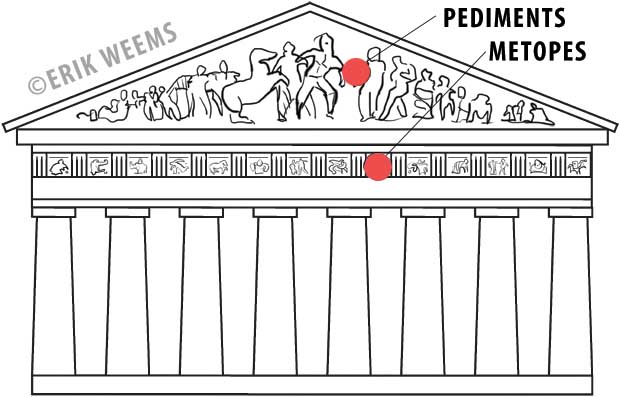
Pediments - these sculpted figures were at either end (north-east and south-east) of the Parthenon and inside the raised triangular roofing space. This area combined with the metope area below is referred to as the "tablature."

Metopes - Sculpted figures set apart from one another on rectangular slabs separated by a triple lined block called a "triglyph."

Frieze - The Frieze is a continuous long series of figures. They were directly behind the metopes separated from it by air space. There were four friezes at the Parthenon, one each facing north, south, east and west. The frieze sat above an interior set of columns, which lined up behind the metopes. Behind the frieze was the block wall building of the actual temple (and inside that was a whole new set of approx. 46 smaller columns stacked into two floors). When looking at the Parthenon, the exterior columns are actually supporting an exterior section which goes up to support the roof (blown away by Venetian shelling in 1687) and behind that exterior line of columns is an interior line of columns (where the frieze were) , and behind that was the block wall of the temple with a large entrance door.
Resources on the Parthenon Sculptures (Elgin marbles):
The 2009 book "Loot" by Sharon Waxman. Waxman describes the history of the removal of the Parthenon Marbles from Greece.
The Search for Ancient Greece from publisher Harry Abrams, 1992. This book covers the activities of archeologists in Greece over hundreds of years, and provides "an examination of the heart of Western culture."
Media Reports on the Parthenon Marbles
An "accelerating campaign" to send Parthenon Marbles back to Greece?
July 11, 2025: Story at MSN Sky News [English]
Time has come to return Parthenon Marbles to Greece
June 9, 2025: Remarks by Baroness Debbonaire, full name Thangam Elizabeth Rachel Debbonaire (née Singh) prominent British Labour politician in the House of Lords – UK The Times [Greek]
Athens was never part of a British colony. Britain supported and fought for Greek freedom whenever it had the chance. Debates about Greek cultural assets are entirely different from the wider argument about restitution..."
British Museum seeks an "innovative" way forward on matter of Parthenon Marbles
May 20, 2025: Story at Parapolitika [Greek]
The 1802 shipwreck of Lord Elgin's transportation craft Mentor continues to be searched for sunken treasure
Feb 27, 2025: Part of the Parthenon Marbles were aboard the craft - story at Greek Reporter [English]
PM Mitsotakis prepares to raise the matter of Parthenon Marbles with British PM Starmer on December 2 when in London
November 16, 2024: Story at Iefimerida [Greek]
UK PM Starmer ‘wants to solve’ the issue with Greece over Elgin Marbles
Thangam Debbonaire, who was shadow culture secretary until she lost her seat at the last election, said she wanted to see the marbles returned to Athens, where they could be "viewed in whole". She suggested that Starmer shared her view, noting that the new government was in a "really historic position to be able to tell a new story” around the marbles..."
October 5, 2024: Story at UK The Times [English]
UK Culture Secretary wants Greece to recognize Uk ownership of "Elgin Marbles" before a loan of them to Greece is made
May 22, 2024: Story at Irish Times [English]
Will the British Museum consider the swap offer from Greece?
"Any deal cannot include ownership issues"
December 28, 2023: Story at UK Times [English]
Employee thefts at UK British Museum raises questions about security of Parthenon Marbles
August 17, 2023 Story at Protothema [English]
Melina Mercouri and the Parthenon Marbles
May 12, 2023: Story at IN GR [Greek]
"You can't borrow what already belongs to you"
January 7, 2023: The Parthenon Marbles - story at EFSYN [Greek]
The international maneuvers over the Parthenon Marbles
January 7, 2023: Story at Kathimerini [Greek]
The items the British Museum seeks in exchange fore the Parthenon marbles
January 5, 2023: Story at IN GR [Greek]
Ministry of the Interior: We do not recognize the British Museum's jurisdiction, possession and ownership of the Parthenon Marbles
January 5, 2023: Story at Athina984 [Greek]
Bloomberg: Parthenon Marbles deal close between UK and Greece
January 3, 2023: Story at Bloomberg [English]
The "red tape" at the UK British Museum
Aug 7, 2022: Story at Kathimerini [Greek]
"Partnership" plan for Parthenon Marbles not moving forward
Aug 2, 2022: Story at MSN - UK Telegraph [English]
Anniversary of the 1982 announcement by Melina Mercouri for the return of the Parthenon Marbles
July 29, 2022: Story at Greek City Times [English]
Debate over reunification of the Parthenon Marbles is "evolving" at the British Museum
July 17, 2022: Story at Eleftherostypos [Greek]
Greek likely to reject any deal from British Museum for fear of "legal trap"
June 24, 2022: Story at UK Telegraph MSN [English]
3D Printers and the Parthenon Marbles
June 17, 2022: Story at UK Guardian [English]
Greece/UK to begin "formal discussion" about Parthenon Marbles
May 19, 2022: Story at Hyperallergic [English]
Is the UK losing the "Elgin marbless" to Greece
November 19, 2021: Story at UK Telegraph [English]
Will EU pressure UK on "Elgin Marbles"?
Feb 19, 2020: Story at MSN News [English] and "Twitter row" at RT Com [English]
"The Museum would be denuded if we give back exhibits"
Jan 2019 - British Museum defends keeping the Marbles - Art Net
June 2018 - Returning the Elgin Marbles to Greece is madness - UK Telegraph
"They're our artworks"
June 2018 - Greece wants Parthenon Marbles back, Tsipras tells May - Reuters
Web site dedicated to the matter of "cultural vandalism"
"Elgin Marbles" pieces found in waters near Agios Nikolaos
Story at Protothema [Greek]
Corner Pediment
More about the Acropolis



Greece's Golden Visa program
Advertisement: I am an Amazon affiliate
Page created October 2018 | Updated July 31, 2025
